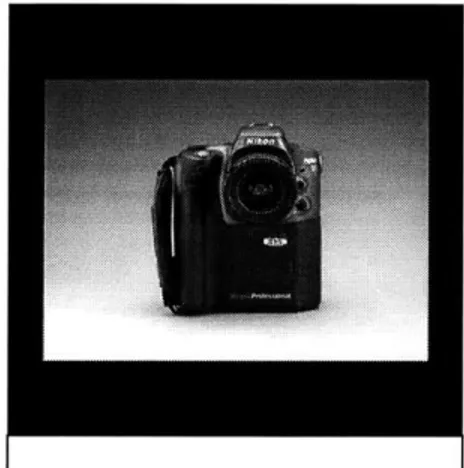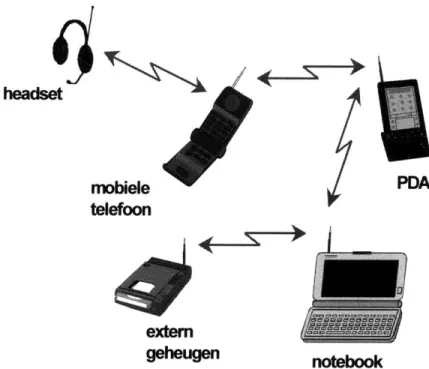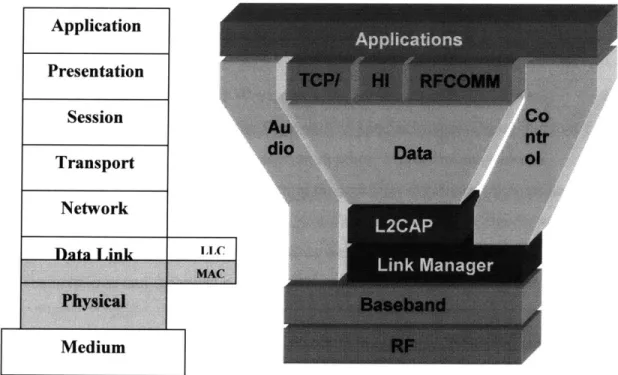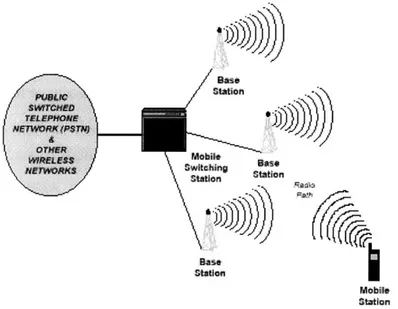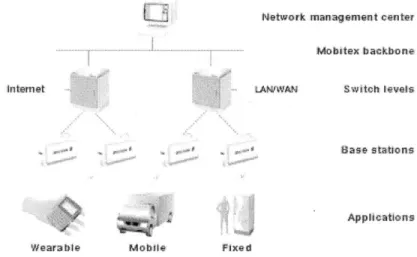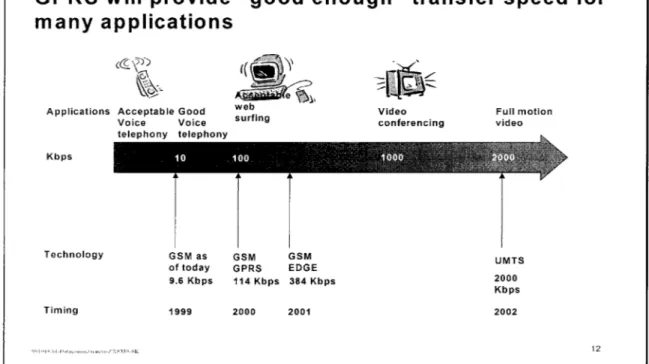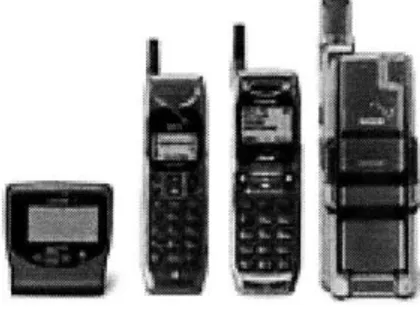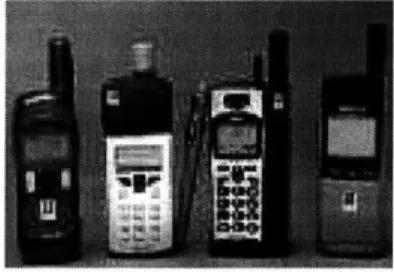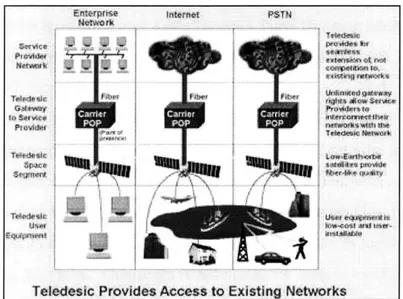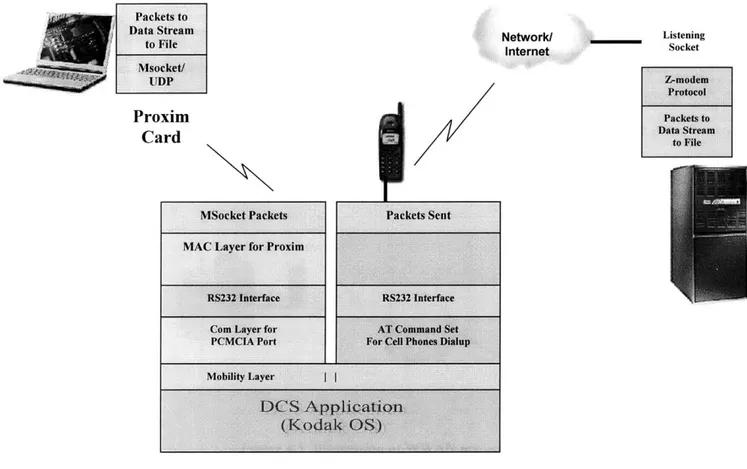Addressing the Complexity of Multimedia Wireless Computing Solutions
by
William W. Graylin B.S., Electrical Engineering University of Washington, 1992 B.A., Chinese Linguistics & Literature
University of Washington, 1992
Submitted to the Sloan School of Management and the Department of Electrical Engineering
In Partial Fulfillment of the Requirements for the Degrees of Master in Business Administration
And
Master of Science in Electrical Engineering and Computer Science At the
Massachusetts Institute of Technology June 2000
@ 2000 Massachusetts Institute of Technology
All rights reserved Signature of A uthor ...
Sloan School of Management May 5, 2000 C ertified b y ...
1- /Sandy Jap Associate Professor, Sloan School of Management Thesis Supervison C ertified by ...
Alvin w. UjraKe
Professor, Department of Electrical Engineering & Computer Science Thesis Supervisor
A ccepted by ... - ....-
Margaret Andrews Execive'Dector of Maet> Pror
- SIQ KofWManaoeent4, A ccepted by ...
A . C . Sm ith Chairman, Committee on Graduate Students Department of Electrical Engineering
MASSACHUSETTS INSTITUTE OF TECHNOLOGY
JUN 13 2000
This page is intentionally blank.
Addressing the Complexity of Multimedia Wireless Computing Solutions
By
William W. Graylin
Submitted to the Sloan School of Management and the Department of Electrical Engineering
in Partial Fulfillment of the Requirements for the Degrees of
Master in Business Administration and
Master of Science in Electrical Engineering and Computer Science
ABSTRACT
The new age of Wireless/Mobile Computing is upon us. This is a part of the convergence between Information Technology, Telecommunications and Media that will reshape the way society
operates. At the dawn of this new era, it is a challenge to navigate through uncharted territory where a plethora of necessary components such as the Internet, hardware, software, firmware, network infrastructure and communication devices collide, where new technologies and standards
are emerging rapidly to outdate the old. In an effort to maintain market leadership and based on customer needs and demand for faster, more efficient and more convenient ways to capture and deliver images, Kodak Professional DCS is looking to employ the latest off the shelf technologies to allow their cameras to wirelessly deliver images to their intended destinations. Adding wireless transmission features to the Kodak's digital cameras can present tremendous value to end
customers, thereby helping to increase market share for Kodak in the face of stiff competition. The challenge of delivering wireless digital image transfer to consumers lies in the limitations and the complexity of a burgeoning but less than mature wireless industry. It requires the integration of a plethora of components, many of which still lack defining standards. These components include: wireless network technologies and providers, network protocols, wireless radios, cellular phones, software architectures and firmware, the camera hardware and operating system and data
connection cables.
This thesis will address the complexities related to delivering wireless computing solutions to a fast-moving market, with special focus on multimedia wireless solutions. The thesis maps out the current wireless computing terrain and selects the most suitable methodologies, architecture and components to deliver wireless multimedia solutions to Kodak Professional Digital Camera Systems
(DCS) customers. The thesis goes through two specific wireless multimedia projects I designed for
Kodak Professional DCS. One deals with the transmission of images directly from DCS cameras via cellular wireless wide area networks (WWAN), and the other deals with networking of DCS cameras within wireless local area network (WLAN) environment. The WWAN project was implemented and the prototype was demonstrated with very positive results at PMA, one of the largest professional photography trade shows of the year. The WLAN project is under
consideration for implementation by the DCS engineering team. The thesis also examines the emerging Wireless Computing industry and how it will impact the way people and businesses operate.
Thesis Advisors: Sandy Jap, Associate Professor, Sloan School of Management Alvin Drake, Professor, Department of Electrical Engineering
Acknowledgements
I would gratefully like to thank all those who have made this project and research a
tremendous learning experience:
I would like to thank the MIT Leaders for Manufacturing Program (LFM) for laying the
foundation to the best learning environment I could have imagined. In particular Don Rosenfield, Bill Hansen, and the rest of the LFM staff.
I would like to thank the Kodak Professional group who were extremely supportive of my
project and contributed greatly to its success. Most of all, I would sincerely like to thank Steve Noble, Vince Andrews, Bill Carleton, Steve Kralles, Jay Kelbley, Jim McGarvey and George Lathrop for sharing their insights and rallying support for the projects within Kodak.
Special thanks to my thesis advisors Al Drake and Sandy Jap. Additional thanks goes to Tom Wala for the sharing of Kodak Professional DCS background information.
Dedication
I would like to dedicate this thesis to my lovely wife Kim, who has given me amazing
support through out the past 5 years of our marriage. We are a team and without her I would be incomplete.
This dedication also goes to all of our family members in Seattle who has been behind us with their love and support all the way.
A b stract ...
. 3
Acknowledgem ent ... 4Table of o
...
5
1. Introduction... 7 1.1. T hesis O bjective ... . 7 1.2. Statement of Problem ... 7 1.3. M otivation ... . . .. 81.4. Wireless Computing Industry Overview ... 8
1.5. Kodak Wireless Projects... 10
1.6. T hesis O verview ... 11
2. Setting and Background For Wireless Kodak Professional DCS P roject ... .13
2.1. Background on Kodak Professional DCS... 13
2.2. Market, Technology & Product Overview ... 14
2.3. Project Scope, Context... 19
2.4. Voice of Customer (VOC)... 20
2.5. Approach to Solution... 21
2.6. Project Solution Overview... 23
2 .7 . S u m m ary ... 2 4 3. W ireless Computing Industry Background... 26
3.1. Wireless Computing Industry Today... 26
3.2. Wireless Personal Area Network (W/PAN) ... 28
3.3. Wireless Local Area Network (WLAN) ... 35
3.4. Wireless Wide Area Network (WWAN) ... 41
3.4.1 Cellular Technology overview... 42
3.4.2 Network Carriers / Operators...46
3.4.3 Other Wireless Data Networks ... 49
3.4.4 Road to Third Generation technology... 51
3.4.5 Satellite Networks... 57
3.4.6 Other Components to WWAN... 66
3.5. Wireless Technologies and Trends... 67
3.6. Other Applications for Wireless Data Communication... 71
3.7. Challenges Facing Multimedia Wireless Solutions... 74
4. Project Description, W ork... 77
4.1. Project Description Overview...77
4.2. WWAN Project Description...80
4.3. WWAN Results, Performance and Future Adaptations ... 82
4.4. WLAN Project Description ... 84
4.5. WLAN Results, Performance and Future Adaptations...88
4.6. A List of Issues With Implementation...90
5.
Conclusion/Recommendations...
92
5 .1. S u ccesses ... . 92
5.2. L essons L earned ... 93
5.3. Synergies of Wireless Within Kodak ... 95
5.4. Recommendations & Path Forward...96
6. Bibliography...
99
Table of Figures
Figure 2.1: Kodak DCS 315 Picture ... 19Figure 2-2: Kodak DCS 520 Picture... 19
Figure 3.1: WPAN illustration...29
Figure 3.2: Functional Diagram of the Bluetooth Stack ... 31
Figure 3.3: Simplified Wireless Cellular Network Infrastructure ... 44
Figure 3.4: Mobitex Network Configuration ... 49
Table 3.1: Summary of forthcoming cellular-data services... 54
Figure 3.5: Illustration of technology path to 3G ... 55
Figure 3.6: Satellite in Low Earth Orbit (LEO)...57
Figure 3.7: Iridium phones...6 1 Figure 3.8: ICO Handsets ... 62
Figure 3.9: Teledesic Network...63
Figure 4.1: Functional Diagram for both WLAN & WWAN Projects...79
Figure 4.2: Illustration of WWAN project...80
Figure 4.3: Illustration of WLAN Project... 84
Figure 5.1: Dynamic Business Model for Kodak Professional DCS ... 93
Figure 5.2: Future Convergence Model... 96
Chapter 1.
Introduction
1.1 Thesis Objective
The Objective of this thesis is to explore and map out the complex and emerging wireless computing terrain and identify the most suitable methodology, architecture and
components required to deliver a set of integrated wireless multimedia solutions to Kodak Professional Digital Camera customers. The thesis goes through two specific wireless multimedia projects I helped design for Kodak Professional DCS. One deals with the transmission of images directly from DCS cameras via cellular wireless wide area networks (WWAN), and the other deals with networking of DCS cameras within the wireless local area network (WLAN) environment. The WWAN project was
implemented and the prototype was demonstrated with very positive results at PMA, one of the largest professional photography trade shows of the year. The WLAN project is under consideration for implementation by the DCS engineering team. The thesis also examines the emerging Wireless Computing industry, that will undoubtedly have a significant impact on the way people and businesses operate.
1.2 Statement of the Problem:
Kodak Professional Digital Cameras ( DCS) wants to maintain market leadership and fulfill customer needs and their demand for faster, more efficient and more convenient ways to capture and deliver images. As part of this effort, Kodak Professional DCS is looking to employ the latest off-the-shelf technologies that will allow their cameras to wirelessly deliver images to its intended destinations. It will eliminate the
time-consuming and cumbersome need to transfer files to a laptop, edit and convert the images and then send images from the laptop via an attaching cell phone, or a wired connection. Adding wireless transmission features to Kodak's digital cameras can present tremendous value to the end customer, thereby helping to increase market share for Kodak in the face of stiff competition. Furthermore, wireless transmission can lead to a host of other multimedia related services and products including Image Kiosks, Internet multimedia, Mobile multimedia, etc. that can further drive Kodak's business in the digital future.
The challenge of delivering wireless digital image transfer to consumers lies in the limitations and the complexity of a burgeoning but less than mature wireless industry that requires the integration of a plethora of components. Many of the components still lack defining standards. They include: wireless network technologies and providers, network protocols, wireless radios, cellular phones, software architectures and firmware, the camera hardware and operating system, and data connection cables. Other issues include the compromise between cost, performance, time to market and the customers projected adoption based on VOC.
1.3 Motivation
One cornerstone for the Eastman Kodak Company from the days of George Eastman himself was to very easily and conveniently deliver pictures to customers. Even though the processes of delivering these pictures may be very difficult and complex, Kodak has always tried to make these processes as transparent to the end users as possible. The saying of "You push the button, we do the rest," holds true in today's digital world as much as it did for the past 100 years in the traditional sensitized film world.
Digital technology is one of the major corporate strategies of Eastman Kodak Company going into the year 2000. As this transition takes place, we have to continue to find ways to make delivering images in the digital age as simple as pushing a button. Wireless Computing Networking can impact the long-term positioning of Kodak Professional Digital Camera System in the marketplace by making the complex simple. Gaining the technological and competitive edge through innovation can truly benefit Kodak's long-term positioning. By providing customers with features they ask for (and sometimes ones that do not realize possible), Kodak can continue to successfully lead the picture industry in the new millennium.
1.4 Wireless Computing Industry Overview
The convergence of Information Technology, Telecommunications, and Multimedia will take place over the next several years. The wireless computing frontier represents the next leap forward towards this convergence and towards even higher productivity and
efficiency for society. Wireless Computing can affect many areas within Kodak by bringing the convenience and productivity improvement, not only to customers, but also to the workforce itself.
Wireless technology is rapidly evolving and continuing to improve. Voice was the first "killer application" for wireless communications. Soon there will be data and multimedia applications that many never thought possible. The Wireless revolution will depend upon technology improvements, the adoption of standards, and how well the customers are
served. Here are some major trends that are taking shape:
e Wireless infrastructure for wide area networks (WWAN) is evolving from
slow data rate connectivity towards 3G (third generation) technology where bandwidth can be over 2 Mbps, allowing the Internet to be "everywhere". 4G wireless systems that are even further out will offer multiple functionalities in one hand set (voice, data, video-conferencing,
SMS, image, and other applications), as well as global roaming and
integration with WLAN & WATM networks.
* Wireless standards such as IEEE 802.11, and IEEE 802.15 (Bluetooth) are being established to deliver interconnectivity between assortments of information appliances in localized environments. Environments include wireless local and personal area networks (WLAN and WPAN).
* Hardware devices that allow communication to take place are becoming smaller, cheaper, faster, with more features to provide a better experience for users. Smart phones and PDAs are converging, and other devices such as digital cameras, laptops, vending machines, and kiosks are being wirelessly enabled.
e Software architectures, Operating systems (OS), and protocols are converging towards standards. Palm, Windows CE, and EPOC are dominating the mobile OS space. Internet Protocol (IP) will be a foundation. There will be interim communication architectures such as WAP and middleware and web-clipping that will be used while
improvements are made and or better architecture and standards prevail.
" New roles are being shaped as Network Operators and Banks battle for the mobile service portal and transaction space - capturing revenue from customers through value added services (VAS.) There are two battles being waged. One is the battle of standards with the other being the battle for the customers. While technology standards are taking shape, the battle for customer's "eyeballs", attention, loyalty, and ultimately their wallets, will be intense.
" New applications and Services will yield dramatic productivity and lifestyle improvements within the next five years. Many of which will be personalized and location base driven - meaning services that deliver value to you intelligently based on where you are at that time.
There is no doubt that the wireless computing industry will yield dramatic changes in the way we operate. Power lies in the ability to access and deliver information and be productive, or entertained anywhere, anytime.
1.5 Kodak Wireless Projects
My project was to help the Advance Technology group at Kodak Professional with
prototyping new features on their Professional Digital Cameras that will allow them to communicate wirelessly with PCs and other devices. The application environments involve both high bandwidth wireless Local Area Networks (WLAN) as well as low bandwidth wireless Wide Area Networks (WWAN). This research project is aimed at not only delivering additional features to the existing product line within Kodak Professional
DCS, but also to help explore other wireless computing devices/appliances and wireless
computing applications within Kodak.
I worked on two separate wireless multimedia projects. One is for the WWAN
environment, to deliver images to any server from a remote location using a DCS camera connected to a cellular phone. The project was intended to enable mobile transfer of images from virtually anywhere using low bandwidth wireless networks. The solution is
ideal for photo journalist (PJ) customers who need to deliver their images to headquarters quickly and efficiently.
The second project aims to find a way to network DCS cameras to a server via high-speed WLAN connections. The server would have the ability to treat the camera as a client or hardware memory device and download selected pictures. One server can have access to multiple cameras, establishing a master station that can monitor cameras in the field. This project is intended for applications such as coverage of sporting events or image capture and marketing within theme parks.
Due to my background and interest in wireless computing as well as the lack of
bandwidth within the DCS engineering team, I was asked to start and head efforts for the two wireless projects. I was responsible for researching the approach and design, as well as the implementation of plans for the projects. Both projects were designed and
definition of work completed during my internship. The WWAN project was
implemented, while the WLAN project is still being investigated by DCS engineering for future implementation.
Other areas of my research project touch on relationships between cameras and kiosks in a WLAN environment, kiosks and servers in a WWAN environment, other wireless digital image applications, productivity improvements for the mobile workforce using wireless computing, and some other wireless computing applications in the consumer arena including email, e-commerce, and Automobile PCs. The research includes studies of the latest in hardware, software and network technologies that will enable the wireless computing space. The scope of my thesis will focus on how to deliver multimedia wireless solutions to Kodak Professional Digital Cameras users, and as additional research I will examine how breakthrough technologies like wireless computing can impact Next Generation Manufacturing (NGM) and improve the way people and businesses operate.
1.6 Thesis Chapter Overview
This thesis is divided into five chapters:
Chapter 1 is an introduction to the thesis. Overview of problem and solution, and
structure of the thesis.
Chapter 2 provides the setting and background for the Kodak wireless multimedia
project. It describes the marketplace for KRPO digital cameras, the technology and product overview, as well as the scope and context of the project. Within this chapter, it also describes the motivation for the project and key concerns of the customers through the voice of the customer (VOC). Finally, this chapter overviews the approach and solution to achieve the project objectives.
Chapter 3 explores today's wireless computing industry and helps map out the different
components and terrain to better understand how to proceed. This chapter will examine three major segments of the wireless market: VPAN, WLAN, WWAN. For each segment I will identify key characteristics (strengths and limitations) and key technologies and tradeoffs to consider. This chapter will also address the specific challenges facing multimedia wireless solutions and interim alternatives to deal with these challenges. This chapter also looks at the greater Wireless Computing Future to explore other areas where wireless computing can be applied which can increase business and personal productivity and change the way we compute and operate in the twenty-first century.
Chapter 4 describes the application of two major projects that can be implemented for
Kodak Professional DCS. The chapter details each project and the reasons for specific choices made for specifications. This chapter breaks down the WLAN and WWAN project into its components to allow the reader a more comprehensive look at the work involved for the two different projects I was responsible for.
Chapter 5 concludes with the results and outcome to date of the projects and provides a
view for KRPO DCS's path forward. The chapter also outlines some other synergies in other areas of Kodak that may benefit from the use of wireless technology and how it can help shape part of Kodak's digital future. This chapter further presents the author's views on key learnings that have been drawn as a result of this research and some recommendations for the sponsored company related to the topic at hand.
Chapter 2.
Problem Setting and Background For
Wireless Kodak Professional DCS Project
2.1 Background
Eastman Kodak Company History and Background
Founded in 1880 by George Eastman with a patent on Dry Plate photography, the Eastman Dry Plate Company went on to incorporate film by 1884, and in 1892 officially became the Eastman Kodak Company. Today, Kodak is headquartered in Rochester, New York and ranks as a premier multinational corporation and one of the 25 largest
companies in the United States with over $14 billion in annual revenue.
George Eastman had four basic Business Principles:
" mass production at low cost " international distribution
* extensive advertising e a focus on the customer.
Eastman saw all four principles as closely related. Mass production could not be justified without wide distribution which, in turn, needed the support of strong advertising. From the beginning, he imbued the company with the conviction that fulfilling customer needs and desires is the only road to corporate success.
To his basic principles of business, he added these policies:
e foster growth and development through continuing research * treat employees in a fair, self-respecting way
* reinvest profits to build and extend the business.
The history of Eastman Kodak Company is one of progress in development of these basic principles and policies. Eastman Kodak Company today develops, manufactures and markets consumer and commercial imaging products. Products of each major segment (Consumer, Kodak Professional, Health Imaging) include film, photographic paper,
processing services, photo finishing equipment, chemicals, cameras and projectors, digital cameras, printers and scanners, chemicals and related services, medical films, motion picture film, audiovisual equipment, etc.
Digital Products Business part of Kodak Strategy
While maintaining its leadership in the traditional film business, Kodak has focused much energy on the digital future. Kodak Professional Digital Camera Systems (DCS) is the world's leader in developing and marketing high-performance digital cameras to professional photographers. As the camera world moves further into the digital arena, Kodak Professional needs to maintain its market power. This market is driven by technological innovation, and Kodak must maintain its superior design capabilities. Digital technology is one of the major corporate strategies of Eastman Kodak Company going into the twenty-first century.
The different market segments served by Kodak Professional are the commercial studio, portrait studio, photojournalism, applied (medical, scientific and industrial) and high-end amateurs. Out of these segments, the product mix has been focused (in descending order) on photojournalism, commercial studio, as well as applied and portrait studio.
2.2 Kodak Professional DCS Market, Technology and Product
Overview
2.2.1 Market Overview
The market for professional digital cameras is very competitive and previously focused more on performance and technology than price. There are about 15 competitors in this market who, in 1999, were competing for an estimated revenue of $250 million.
Competitors include large companies such as Canon, Nikon, Fuji, Minolta and Sony that Kodak also competes with in film photography. Smaller companies, such as Leaf and PhaseOne, are also included in this market. The Kodak-manufactured professional digital cameras are the market leaders in this industry. Two of the top nine companies in the high-resolution digital camera market have their products manufactured by Kodak.
Market Becoming More Competitive
A prime example of the increased competition is shown by the September 1999
introduction of Nikon's D-l Professional Digital Camera - the first real threat to Kodak's dominance in the market-place. Now with true competition in the market, Kodak needs to deliver better features to the customer in order to maintain its leadership as well as open up new opportunities.
A major differentiator between the professional digital cameras is the resolution and
quality obtained by the image sensor, which captures and processes the image into a digital output. Kodak also has tremendous capabilities in image processing after the digital capture. The rest of the camera is a traditional SLR, except that many of the inside components (motors, etc.) of the camera are removed to make room for the image sensors, circuit boards and color LCD display. The use of SLR bodies was originally based on the assumption that professional photographers and photo journalists (PJs) have invested a lot of money on Nikon and Canon lenses and would be more willing to buy a digital camera should it allow them to continue using their high performance lenses. Those assumptions may have been correct at the time, but many customers are now buying professional digital cameras because they can obtain and deliver quality images much faster, save money, and simply because they can now do their jobs better. One major reason for Kodak's leadership in this market has been the inability of competitors to match the digital resolution obtained by the Kodak digital cameras.
The competitors, however, are making strides in this area. Other than Kodak's internal expertise in image sensor manufacturing, there are a very limited number of sensor suppliers, providing these companies with pricing power in the market. The technological expertise and high start-up costs required also reduce new entrants from entering the market. Today, although Kodak is still the leader in providing superior imagers, others in the market are closing the gap, thereby making it easier for new entrants to compete in the high-end digital camera marketplace. New arrivals will be more integrated units that come in smaller form factors and will be packed with the latest features. Kodak must be able to respond to these challenges with compelling new products of their own at an increasingly competitive price.
2.2.2 Technology Overview
As their competitors' technology improves, Kodak Professional can only ensure itself that it will remain the market leader in this high-tech industry by meeting the
performance needs of their professional customers in as many ways as possible. As stated above, the main driver of the professional digital camera industry is the technology and performance of the image sensor used in the camera. Kodak must continue to
innovate and keep improving image quality to stay ahead of its competitors. The two competing image sensor technologies are the charged-coupled devices (CCD) and complementary metal-oxide silicon (CMOS) devices.
The CCD was invented in the late 1960s by researchers at Bell Labs. Although originally conceived as a new type of computer memory circuit, CCD sensors were quickly used in many applications including signal processing and imaging - the latter because of the light sensitivity of silicon. The CCD sensor in a digital camera is the primary tool to capture an image. The sensor collects light and converts it to a charge and subsequently emits a signal that results in a digital image. Kodak's CCD sensors are comprised of thousands of pixels grouped in either a linear or matrix array to register the overall light intensity of each point in a scene. A color image can be obtained with the addition of filters, in a proprietary red-green-blue pattern, during the CCD sensor manufacturing process.
Kodak uses its proprietary CCD technologies to make the highest resolution cameras on the market. In 1998, the resolutions on the two main products developed and
manufactured for Kodak Professional were 1.5 million-pixels (or mega-pixel) in the DCS
315 and 2.0 million-pixels in the DCS 520 camera model. In 1999, the newly introduced DCS 560 features an image sensor with a 6 million-pixel resolution. In comparison, the
image resolution of photographic film is about 16 million pixels, but digital technology is forecasted to meet such resolution in the next five years.
In contrast, the CMOS devices are currently not able to achieve such high resolution as the CCD. However, many engineers at Kodak believe that in the next five years CMOS may be able to match or even go beyond the resolutions offered by CCD sensors. One advantage of the CMOS technology is that it utilizes the same processes used to make microprocessors. Therefore, CMOS sensor manufacturing could inherently achieve higher process yields that would significantly reduce the price of these sensors. In response to the CMOS threat, Kodak formed an alliance with Motorola to work together on the next generation of image sensors. This partnership will allow Kodak to share its world-leading digital image sensor design expertise, while enabling Motorola to utilize its world-class process technologies.
Other than the image sensors, Kodak also has developed tremendous competence in the way the images are processed digitally. This is also another area in which Kodak
distinguishes itself from the competition. Furthermore, current Kodak Professional digital cameras have multiple communication/storage ports that allow the camera to be more flexible and expansive than any other camera on the market. The key is treating the camera more as a system, which allows the user to more effectively do their job.
2.2.3 Product Overview
The digital camera product lines of Kodak Professional include the following main model families: DCS 315, and DCS 500 / 600 series. Next generation products in the pipeline will not be discussed in this paper.
DCS 315. The DCS 315 camera is the most affordable
camera product. It combines a high-resolution digital camera with the versatility and functionality of a Nikon SLR. The camera features a 1.5 mega-pixel CCD sensor with variable ISO speeds (100-400). The camera can use interchangeable lenses from Nikon. This allows the re-use of lenses (previously re-used with the reloadable cameras) which lowers the photographers' cost of
Figure 1. Kodak DCS 315
switching to digital. The camera also includes a color Digital Camera LCD that allows instant review of the images as well as
storage of exposure information, date/time stamping, thumbnail images and voice recording. Finally, the camera has dual PCMCIA slots for removable PC cards that store the images.
DCS 500 & 600 Series. The DCS 500 & 600 series are
the flagship digital cameras for Kodak Professional. The
DCS 520 includes a 2 mega-pixel, full ISO 200-1600, and
rapid burst rates of up to 3.5 images per second. In addition, it is built around the Canon EOS camera subsystem, which allows for interchangeable lenses. As the newest product in the product line, the DCS 560 features a 6 mega-pixel sensor, ISO 80-200, and is also
built on the Canon EOS camera subsystem. The DCS Figure 3. Kodak DCS 520 600 series is essentially the same as the 500 series except Digital Camera
they use Nikon F-I camera bodies and lenses.
2.3
Project Scope and Context
"With the slogan 'you push the button, we do the rest," George Eastman in 1888 put the first simple camera into the hands of a world of consumers. In so doing, he made what had been a cumbersome and complicated process easy to use and accessible to nearly everyone.
Through the years, Kodak has led the way with an abundance of new products and processes that have made photography simpler, more useful and more enjoyable. Today, our work increasingly involves digital technology, combining the power and convenience of electronics with the quality of traditional
photography to produce systems that bring levels of utility and fun to the taking, "making" and utilization of images.
What George Eastman began remains a goal of Eastman Kodak Company today, to provide convenience and quality to our customers so more and more people can experience the special wonders ofphotography and capture and re-live their more cherished moments."
George M. C. Fisher
Chairman, President and CEO Eastman Kodak Company
The Wireless Computing/Networking project can impact the long-term positioning of Kodak Professional Digital Cameras in the marketplace as well as in many other areas within Kodak. My background and interest in the wireless computing and networking arena led me to Kodak's latest development efforts in this area. Kodak, in fact, has multiple projects that involve wireless computing, from both a product development standpoint as well as an operational and productivity improvement standpoint. Gaining the technological and competitive edge with the most advanced technologies and concepts can truly benefit Kodak's long-term positioning.
My primary project is to help the Advance Technology group at Kodak Professional with
prototyping new features on the Professional Digital Cameras. These features will allow the DCS cameras to communicate wirelessly with computers, in both high-speed wireless Local Area Networks (WLAN) as well as low bandwidth wireless Wide Area Networks (WWAN).
The WLAN project involves building the capability for multiple DCS cameras to be connected and monitored by a host server wirelessly within a localized environment, such as a sports arena, allowing the host server to be able to pull images from the cameras without disturbing the photographer.
The WWAN project involves building the capability for images to be sent directly from the camera to any receiving computer in the world via a cellular phone. This eliminates
the need for photographers to carry around a heavy laptop, transfer the images to the laptop, edit the image and then send the image via a separate wireless modem or cell phone.
Other areas of application for wireless computing for Kodak touch on:
" Relationships between cameras and kiosks in a WLAN environment " Kiosks and servers in a WWAN environment
" Wireless images transfers for people to communicate
* Wirelessly enabling information appliances with computers and printers
e Productivity improvement capabilities for the mobile workforce using
wireless computing from emails and calendars, field service and sales force automation programs.
The thesis examines how the latest in hardware and software technologies can enable and change the way businesses operate for the better.
2.4 Voice of the Customer (VOC)
There had long been demand from the customer for better means of transmitting
data/images from the camera to its intended destination. Voice of the customer had been gathered from various fronts, and the results were tabulated into spread-sheets. From the data of the VOC came some interesting results that formed the basis of the project. The
VOC were collected from interviews of more than ten news agencies in several countries,
both locally and in Europe. Below is a summary of the results as it pertains to
transmission of images from the camera after capture. Most of the customers interviewed are in the Photo Journalist (PJ) market segment, which also consists of Kodak
Professional DCS's largest customer base.
Summary:
Of the pictures that PJs must deliver, most are sent from a remote location rather
than personally coming back to the office with the images. The remote
transmission is typically done by transferring pictures to a laptop, editing them to a smaller file format and sending them out via either a cell phone or land-line phone modem. Reliability and usability are very important to the customers. The
VOC results show that significant numbers of PJ customers are asking for better ways to remotely transmit their images. Their goal is to be able to effectively and
efficiently deliver their images to the right hands. Their pay as well as the news agency's profit depends on getting those "great shots" delivered first. Other news agencies and publications that purchase the images from the source will be less willing to pay for pictures of an event that already had coverage from someone
else. Getting great shots to market first is key in the PJ environment.
2.5 Approach To Solution
This section describes the procedure and time line for the thesis and project. Discuss the
approach used to come up with a solution, and detail some of the reasons behind the approach.
Procedure and Time Line:
The project follows the procedures outlined below (dates are June 1999 through Apr
2000):
June Learn about the Kodak Professional DCS business and technologies; get to know organization and sketch out project plan
July Research Professional Digital Camera market environment, gather and understand
VOC data. Outline project requirements
Aug Research wireless computing arena and necessary components, gather data, attend
trade show, prepare midstream presentation
Sept Conduct analysis based on results of data analysis; Prepare roadmap
recommendations based on analysis results
Oct Identify suitable components according to project definition and needs. Solidify business model, buy in and funding for project.
Nov Begin implementation of prototype based on roadmap, analyze other applications
within Kodak for wireless computing.
Dec Continue implementation of project and the exploration of the emerging wireless computing market. Prepare final presentations
Jan Consolidate data and results, prepare thesis, and present results and additional recommendations.
Feb Prepare thesis document
Mar Complete thesis draft and obtain thesis approval
Apr Complete thesis final draft, turn in drafts to appropriate offices
Approach:
My approach for the Kodak Professional DCS wireless solution projects consists of eight
steps:
e Understand the Professional Digital Camera Market
" Understand VOC and What Customers Want " Understand Kodak's position and competence
e Understand Capabilities and Limitations of Wireless Space (hardware, software, firmware, networks, technology, etc.)
" Explore Options for Kodak Wireless Multimedia Solution " Propose Architecture and Design Plan
* Help Develop Prototype
" Recommend Future Adaptations
First, I must understand the needs of the customer through VOC. There were already some VOC data that had been collected in the previous 12 months. The best way to understand Kodak's own position and core competence was to interview internally. Next, research was to be conducted on all that is available on the wireless computing
space to find suitable networks and equipment/software vendors and technologies for the
U.S. and for Europe. This understanding must be applied to help explore all options that
can facilitate a rapid proof of concept and prototype development.
The bulk of the research came in exploring the evolving industry of wireless computing. This was done through going to trade shows, calling and interviewing vendors for hardware, software, networks, services, etc. Obtaining information on the web was very useful here. Talking to industry experts also helped a great deal.
Although there is a lack of wireless computing expertise within the Kodak Professional
DCS group, there are scattered amounts of expertise throughout Kodak in different
divisions who are working on other types of wireless projects as well. Harnessing some of their experience can certainly be helpful in the future.
Next came the task of sorting through the options down to ones that would fit Kodak's needs the most. Selection criteria are based on the camera's hardware and firmware specifications, the project objectives and requirements, limitations in funding and other resources. The culmination of all of the above went into the architecture and design proposal, to recommend a design that will meet the needs of current customers as well as attract future users of our products. Planning and definition of work was created for each project and prototyping and testing begins. Finally, suggestions could be made for future releases of the cameras on features, functions and architecture.
Note: Much of the market research was done through interviews inside and outside of Kodak, and through web and printed media.
2.6 Project Solution Overview
Below is an overview to the WLAN and WWAN project solutions. More details is shared in Chapter 4 of this thesis. As described above, I led the research and design of two separate wireless multimedia projects with different requirements and end results.
WWAN Project:
The first project is to develop a proof of concept prototype that can deliver digital images to a server from a remote location with a Kodak Professional DCS camera using a cell phone as a dialup modem. The project was intended to enable a mobile transfer of
images from virtually anywhere using low bandwidth wireless networks. Ideal customers are photo journalists who need to deliver their images to headquarters quickly and
efficiently.
The appropriate networks were selected for the U.S. and Europe (the two major markets being served. Several of the latest model digital phones were selected as a dialup modem that connects to a remote server using Z-modem protocol with appropriate adaptors used to connect phone and camera. Software controls and Graphical user interface (GUI) were also developed.
to connect phone and camera. Software controls and Graphical user interface (GUI) were also developed.
I completed the design and definition of work for this project during my internship. The
project was implemented, and the end result was a working prototype that was
demonstrated at the PMA show in Las Vegas in early Feb 2000. Quality Assurance (QA) is underway, and roll-out to the public is expected by the second quarter of this year.
WLAN Project:
This project was aimed at finding a way to network DCS cameras to a server via high-speed WLAN. The server would have the ability to treat the camera as a network client or hardware memory device and select pictures to bring across from camera to server. One server can have access to multiple cameras. The proposed solution would consist of choosing the appropriate WLAN equipment platform within the IEEE 802.11 standard. Software development for the camera and server side would be outsourced to a leading wireless middleware solution provider. The solution would use a Proxim RangeLan2 card in the camera's PCMCIA slot to communicate with a server (likely a laptop) via an Access Point. The GUI for the camera and the application for image processing on the
server would be developed internally. A communication stack would be developed for the camera's operating system (OS) to talk with the Proxim card, which in turn talks to the server. The application for the server would be able to monitor multiple cameras out in the field as clients view thumb-nail sketches of the images captured by these client cameras and then could select particular shots to download to the server.
I also completed the design and definition of work for the WLAN project which is
currently being evaluated for implementation by the DCS engineering team.
2.7
Summary.
For over one hundred years, the Eastman Kodak company has followed the basic
principles and policies set forth by George Eastman himself. This includes the policy to foster growth and development through continuing research. The Kodak Professional Digital Camera division and the Advance Technology group is doing just this to improve market competitiveness and fulfill customer demand and requests. Due to increased
productivity of its users and lead the industry into the next millennium. Two wireless multimedia projects were identified. One for the low bandwidth WWAN environment allowing a user to send images directly from the camera to a server via a cellular or satellite phone from virtually anywhere in the world, and the other for the higher
bandwidth WLAN environment, allowing multiple cameras to be networked wirelessly to a server, which can monitor images captured on each camera and upload the selected picture. The approach used for these projects was to understand the professional digital camera market, the customers, internal competence and to understand the current wireless computing industry and what is available to help implement the projects, sort out the viable options, and define the design and work to implement the projects. The WWAN project has been completed and will be soon available to Kodak's customers. The
WLAN project still being investigated by DCS engineering for future product release.
Chapter 3. Wireless Computing Industry Background
3.1
Wireless Computing Industry Today
The convergence of Information Technology, Telecommunications, and Multimedia is underway. The wireless and mobile computing frontier represents the next leap forward towards this convergence and towards even higher productivity and efficiency for what some people have referred to as the "Mobile Information Society". The Wireless revolution will depend upon technology improvements, the adoption of standards, and how well the customers are served. Here are some major trends that are taking shape:
* Wireless infrastructure for wide area networks (WWAN) is evolving from slow data rate connectivity towards 3G (third generation) technology where bandwidth can be over 2 Mbps, allowing the Internet to be "everywhere". 4G wireless systems that are even further out will offer multiple functionalities in one hand set (voice, data, video-conferencing, SMS, image, and other
applications), as well as global roaming, and integration with WLAN & WATM networks.
* Wireless standards such as Bluetooth, IEEE 802.11, and 802.15 are being established to deliver interconnectivity between assortments of information appliance in localized environments. Environments include wireless local and personal area networks (WLAN and WPAN).
* Hardware devices that allow communication to take place are becoming smaller, cheaper and faster, with more features to provide better experience for users. Smart phones and PDAs are converging, and other devices such as digital cameras, laptops, vending machines, and kiosks are being wirelessly enabled.
* Software architectures, Operating systems (OS), and protocols are converging towards standards. Palm, Windows CE, and EPOC is dominating the mobile
OS space. Internet Protocol (IP) will be a foundation. There will be interim
communication architectures such as WAP and middleware and web-clipping
that will be used while improvements are made and/or better architecture and standards prevail.
* New roles are being shaped as Network Operators and Banks battle for the mobile service portal and transaction space - capturing revenue from
customers through value added services (VAS.) The two battles being waged are the battle of standards and the battle for the customers.
* New applications and Services will yield dramatic productivity and lifestyle improvements within the next five years, many of which will be personalized and location base driven - meaning services that deliver value to you
intelligently based on where you are at that time.
There is no doubt that the wireless computing industry will yield dramatic changes in the way we operate. Power lies in the ability to be access and deliver information, be
productive, anywhere, anytime. This chapter is aimed at surveying different components of the wireless computing space and providing enough background information to better navigate the fast-changing terrain.
Understanding the Wireless Market Place:
To understand the wireless computing space, we must examine the different market segments and components that make up this space. The wireless industry can be divided into three major segments that are separated by environment and applications. Each segment requires different components and has different characteristics and different applications. For the time being, one should not simply say "wireless computing" without being more specific as to what environment and application is being referred to.
WPAN vs. WLAN vs. WWAN:
The first distinction we must make is the difference between the Wireless Personal Area Network (WPAN) market, Wireless Local Area Network (WLAN) market and Wireless Wide Area Networks (WWAN) market.
WPAN is designed for communication of information appliances (IA) within close proximity of one another (10 meters or less.) For the purpose of this paper, HomeRF is
described within the WPAN framework. Key components to WPAN include the embeddable radio transceiver, the standards and protocol for transmission, and security and access control. Key differential issues are range and cost.
WLAN are allowed greater power and thus extends to far greater distances than WPAN,
allowing computers and lAs to be networked together in an environment such as an office building, a warehouse, airport, hotel, etc. WLANs also allow roaming and backbone network access. (Note that similar technology is used for what is described as wireless metropolitan area networks, (WMAN) IEEE 803.16 (typically licensed systems), but for the purposes of this paper they will be described in the same category as WLAN.) The components for WLAN are the radio transceiver, access points (repeaters) and the protocols that network them together.
Finally, WWAN extends into wide area cellular and satellite coverage. WWAN is more complex than the first two environments. Key components include the network
infrastructure that provides signals, the carriers who bill for the services, the transmission standards/protocols that determine performance of the data link, the cellular modems which can be handsets or dedicated modems, the computers or lAs themselves, and the software architecture or middleware that enables applications to be delivered via a given data network.
3.2
Wireless Personal Area Network (WPAN)
Technologies in the WPAN arena are driven by the Bluetooth standard. This represents technology that is typically embedded on information appliances that can transmit and receive within 10 meters of each other. With over 1,500 members of the Bluetooth Special Interest Group (SIG), development of specification version 1.1 was announced in July 1999. The roadmap for the SIG calls for Bluetooth end products to become available from a wide variety of suppliers. The current Bluetooth standard has the advantage of low power consumption and is embeddable to most information appliances such as cell phones, laptops, PDAs, printers, and much more. The current proposed throughput is less than 1 Mbps. The number of nodes (number of users in one local network environment) is still limited to 7, with a range of about 10 meters.
WPAN will evolve in the coming year with IEEE 802.15.3 standard being pushed by
IEEE to far greater bandwidth (up to 40Mbps supporting multimedia), and greater range.
HomeRF, which is an effort to push for low power, short range and a higher bandwidth standard than Bluetooth for networking home computer/lAs is perceived to be caught in the middle of Bluetooth and WLAN technologies. It lacks the performance of the
802.15.3 specifications, and potentially costs more. Home RF could be characterized as a
"trimmed down 802.11" technology.
The primary applications for WPAN will involve devices communicating within the proximity of a room without the use of wires. Using WPAN technology, Cell phones, Laptops, PDAs, Digital Cameras, Kiosks, Printers, etc. can communicate with one another and transfer information back and forth. A useful example of WPAN is in the case of your cell phone wirelessly communicating with your Laptop or PDA, to eliminate need for connection cables and allow your computing device to dial out to the internet even when your cell phone is in your pocket or handbag.
headse
mobiele
telefoon
extem
geheugen
Figure 3.1: WPAN illustration
notebook
Sloan-EE/CS Thesis. Will Graylin
PDA
b 'OF
i
BlueTooth:
Bluetooth is being pushed as the de facto standard for personal area wireless networks. It is a low-power, short-range, flexible, wireless technology specification designed for local area voice and data communications. The system operates in the ISM 2.45 GHz band, providing license-free operation in the United States, Europe and Japan. The goal is to
open a whole new dimension of applications and appliances by enabling short-range,
low-power, unlicensed, wireless connectivity from the hand-held device to a myriad of
other devices including PCs, consumer electronics, point-of-sale transaction terminals,
cell phones, pagers, Internet proxies and other electronic devices.
Current Bluetooth Specs:
Bluetooth uses a short-range radio link built into a 9 mm x 9 mm microchip. The protocol
enables the exchange of information between many devices, including mobile telephones, PDAs, notebook PCs, handheld PCs, associated peripherals, and home hubs, which may
include Home RF. The radio will operate on the globally available 2.45 GHz ISM "free
band," meaning there will be no hindrance for international travelers using Bluetooth-enabled equipment.
The Bluetooth baseband protocol is a combination of circuit- and packet-switching,
making it suitable for both voice and data. Each voice channel supports a 64 Kbit/s
synchronous (voice) link, and the asynchronous channel can support an asymmetric link of up to 721 Kbit/s in either direction, while permitting 57.6 Kbit/s in the return direction.
All in all, this is sufficient to cope with the vast majority of proposed data rates over
cellular systems. The nominal link range is 10 cm to 10 m, but links can be extended to
more than 100 m by increasing the transmission power.
The software framework in the proposed specification would require Bluetooth-compliant devices to support a basic level of interoperability. The level of compliance will vary depending on the device application. For some applications, this will extend from radio module compliance and air protocols, to application-level protocols and object exchange formats. Below is a Functional Diagram of the BlueTooth Stack.
Application Applications Presentation Session Transport Network EECi -Data Link:5 MAA Physical Medium
Figure 3.2: Functional Diagram of the Bluetooth Stack (source: Motorola)
802.15.3 High Speed WPAN:
The initial Bluetooth standard is lacking in several respects and there is a ground swell being built towards a new standard that will be faster, have greater range and be more robust than the current 802.15.1 standard. A group of talented engineers within Kodak has developed a patented wireless transmission technology they hope will now be the standard that supports multimedia. This technology is being proposed to the IEEE organization as the 802.15.3 standard.
The IEEE 802.15 WPAN Working Group is doing work in an accredited Standards Development Organization. Both the HomeRF Working Group and the Bluetooth Special Interest Group are informal consortia-based groups defining wireless networks.
HomeRF could be characterized as a "trimmed down 802.11". Bluetooth is a newer addition to the wireless space and comes closer to satisfying WPAN requirements.
The primary 802.11 design criteria are different from those of the WPAN. The WPAN functional requirements are simpler, yet there is a much greater concern over power consumption, size, and realizable product cost. This is due to the WPAN focus on the requirements of wearable computing and peripherals.
The first project of the IEEE 802.15 Working Group for Wireless Personal Area
Networks (WPANs) is derived from the BluetoothTM Special Interest Group Version 1.0 Specification, Foundation Core and Foundation Profiles, that addresses wireless
networking of protocols and mobile computing devices (e.g. organizers, laptops, and cell phones). This is in keeping with the working group's objective to work closely with special interest groups and industry consortia, as well as with industry to solicit input on market requirements and technical solutions.
One of the major goals for IEEE 802.15 as well as for the Bluetooth Special Interest Group (SIG), is global use of wireless personal area network (WPANs) technology. Devices using the IEEE 802.15 WPAN and Bluetooth technology will provide country-to-country usage for travelers. They will be able to be used in cars, airplanes and boats and truly be international.
Because of this, much of the Bluetooth(TM) technology is focused on a single specification that meets the worldwide regulatory requirements that fall into two
categories: security and spectrum/power. As the radio link will contain private business and personal data/voice, security is a requirement. As security is heavily regulated worldwide, the technology has to conform or work with the various worldwide agents to ensure it meets these requirements.
The Bluetooth specification allows portable and mobile computing devices, such as organizers, laptops and cell phones, to communicate with one another and interoperate
and is focused on security and global spectrum/power requirements. The standards created by the 802.15 working group will provide the foundation for a broad range of interoperable consumer devices by establishing universally-adopted standards for wireless digital communications. The goal of the 802.15 group is to create a consensus standard that has broad market applicability and deals effectively with the issues of coexistence with other wireless networking solutions. As mobile wireless technology increases, IEEE 802.15 standards are anticipated to be a major growth area for IEEE Local and Metropolitan Area Network standards (IEEE 802 standards), and the IEEE-SA.
In regard to spectrum and power, the technology needs to travel with the user. Unlike a typical WLAN that is set up in one area and rarely moved, WPAN mobile devices travel with the users. As such, the technology needs to be designed such that a single
technology meets the spectrum power requirements of the world.
Possibilities:
Imagine a world where you can be linked to whatever you think of, to manage your life, to consult, to transact, to travel simply, to do business creatively, or to share an idea or a joke with a friend. Imagine a world where your Personal Area Network serves you with what you need when you need it, allowing you to do more with your life.
e You have instant, automatic access to your personal and business data
* Your electronic devices wirelessly and spontaneously synchronize with each other
e You access your email and Intranet / Internet from wherever you are
* You are able to instantly network with airlines, hotels, theatres, retail stores and restaurants for automatic check-in, meal selection, purchases and electronic payments
Bluetooth enables the creation of wireless Internet gateways that allow Bluetooth-equipped devices to access the Internet quickly and easily. This kind of network can host an infinite suite of User Applications, such as being able to wirelessly synchronize with your desktop and access your e-mail and Intranet / Internet from remote locations.
Imagine being able to spontaneously network with airlines, hotels and car rental agencies for automatic check-in, seating / room assignments, meal selection, purchases and
electronic payment. Personal Area Networks also allow devices to work together and share each other's information and services. For example, a web page can be called up on a small screen and then can be wirelessly sent to a printer for full-size printing. Personal Area Networks can even be created in one's vehicle, helping to bring increased safety and convenience via devices such as wireless headsets and Bluetooth speaker systems.
Despite the great things that Bluetooth and WPAN is promising to deliver, there are significant technological and consumer behavioral challenges to overcome. For example, how will tens or hundreds of devices within a localized environment such as an airport or shopping mall talk to each other? How will security be handled? Can the information on my wireless PDA be stolen by someone else within my proximity? Can others detect my presence at a location without my permission? Will I be intruded by unwanted spam wherever I go? These are some of the questions that must be addressed before the wonderful possibilities of WPAN becomes ubiquitous.
(Source: Motorola, and IEEE)
3.3 Wireless Local Area Network (WLAN)
Technologies in the WLAN arena allow for networking of computers with locally installed transmitters and receivers at greater bandwidth and range than WPAN at this time. Bandwidth for WLAN is relatively high. Currently popular versions from companies such as Proxim, Lucent, Symbol, Aironet, RadioLan, and others allow for throughput of about 1.6Mbps. Soon these throughput rates will increase to 11Mbps and even 20Mbps or higher. WLAN solutions can be very effective in keeping computers and devices networked without the tether of wires in a localized environment such as a building, a warehouse, or a compound. There are more and more WLAN solutions being deployed around the world, from enterprise solutions in Walmarts, warehouses, hospitals and office buildings, to limited horizontal solutions at some major airports and hotels that provide travelers high-speed internet access. The drawback of WLAN is its coverage area and power consumption. Many of these high frequency (2.4Ghz or higher) systems can only cover a few hundred feet in diameter, hence making them "local" and require large numbers of transmission points in order to have adequate coverage, which makes it costly. Furthermore, the radios drawing a fair amount of power and size is still a
concern, making it unsuitable at the time for an embeddable radio. For many companies, a WLAN solution can still be very attractive in terms of flexibility, effectiveness and even cost when compared to alternative wired networks.
There are two very different spread spectrum RF technologies being used for the 2.4GHz wireless LAN environment with both supporting the common IEEE 802.11 MAC
standard. They will be described in the following sections. (Note that some WLAN manufacturers are stepping up to the 5GHz frequency range for larger bandwidth
delivery; however, the tradeoff is typically in range and early cost.) For purposes of this report, we will primarily focus on the popular 2.4GHz range. The FCC and its
counterparts outside of the U.S. have set aside bandwidth for unlicensed use in the so-called ISM (industrial, Scientific and Medical) bands. Spectrum in the vicinity of 2.4GHz, in particular, is being made available worldwide.
Spread Spectrum
